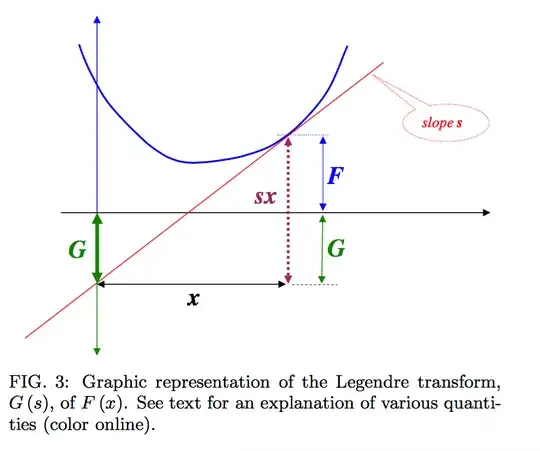See Making Sense of the Legendre Transform and Legendre Transforms for Dummies.
Look at the following diagram from the first link:
I was trying to think of the simplest example to interpret this physically: consider the graph of kinetic energy versus magnitude of velocity: $T(v) = \frac{1}{2}mv^2$. (i.e. $x:=v$)
Then $s= \frac{d}{dv} T(v) = mv = p$ the magnitude of the momentum obviously.
Furthermore, $sv= pv = mv^2$. $F=T(v)=\frac{1}{2}mv^2$, and since $sv = F+G$, it follows that $G(s)=mv^2 - \frac{1}{2}mv^2 = \frac{1}{2}mv^2 = \frac{s^2}{2m}=\frac{p^2}{2m}$.
However, for a general Legendre transform, $G$ is just the negative of the intercept of the tangent line -- so what is the physical interpretation of the fact that the negative of the intercept of the tangent line to the graph of $T(v)=\frac{1}{2}mv^2$ is always equal to $T(v)$ itself? Is this mathematical fact a result of isotropy of space or some other symmetry we assume (presumably a similar but not identical fact would hold for relativistic mechanics, for example)?
What is the physical significance of the fact that $T(v)=F(x)=G(s)=T(p)$?
Also in the second link, it describes the Legendre transform as transforming between "conjugate variables". What does it mean physically for two quantities to be conjugate variables? What is the physical significance of the fact that velocity and momentum are conjugate variables? Why are they conjugate variables? Does it relate somehow to $F(v)=G(p)$?
These questions are almost certainly very silly, so I very much appreciate your patience with me and any help which you might be able to provide.
Note: This question is NOT a duplicate of this question; I am asking about a specific aspect of the Legendre transform.
EDIT: apparently this is supposed to mean something about velocity and momentum being "convex conjugates" -- but I still don't see what the physical interpretation of "convex conjugate" is nor of the graphical relationship it is supposed to imply.
